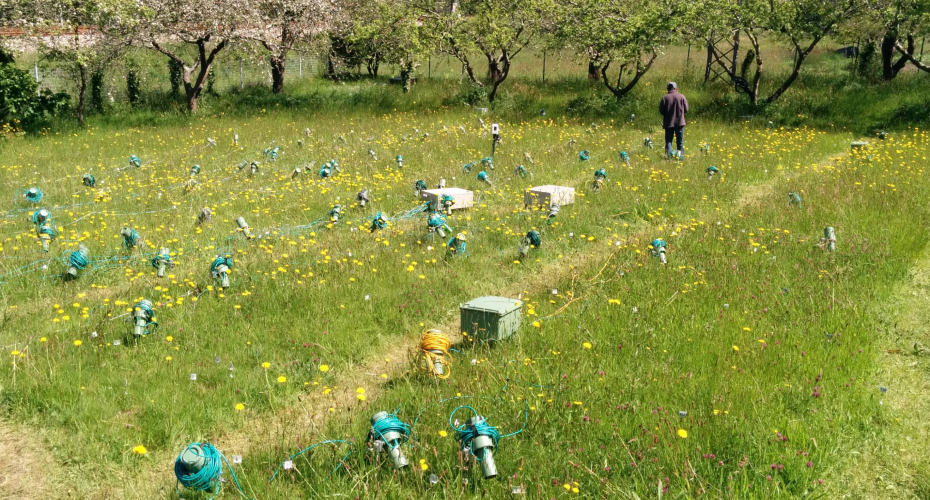A unique research project studying the natural behaviours of a population of crickets in northern Spain has celebrated 20 years of ground-breaking fieldwork.
Wildcrickets, led by a team of biologists at the University of Exeter, Cornwall, has been likened to an insect reality TV show as it has recorded in intimate detail the lives and loves of crickets during the spring and summer breeding season.
Based in a meadow in the principality of Asturias, researchers from the Centre for Ecology and Conservation in Penryn, use 140 infrared cameras to monitor the behaviour of the insects as they negotiate predators and the ticking of their short biological clocks.
In the space of less than two months, the team traps and tags up to 700 crickets, extracts a minuscule sample of DNA, and records hundreds of thousands of hours of video footage, an exhaustive process that has enabled them to shed new light on the insects' behaviour and the challenges they face.
"It's been described as a soap opera, a Big Brother house for crickets," says Professor of Evolutionary Ecology, Tom Tregenza. "It has everything: life, death, fighting, mating, even tragedy. It is evolutionary biology and behaviour under natural conditions, and as a research endeavour, it is unique in its longevity and ambition. No one has ever done something like this for so long."
The project began in 2005, when Exeter researcher Dr Rolando Rodriguez-Munoz returned to Spain for family reasons and discovered that the meadow belonging to his parents was home to many crickets.
Dr Rodriguez-Munoz had been studying the insects for several years with Professor Tregenza before his relocation – but a critically endangered population in the UK combined with the limitations of lab-based studies had left the team looking for a new challenge.
With funding from the Natural Environment Research Council (NERC), they set up 16 cameras in that first year and proved that the concept had potential. Two decades later, the number of cameras has increased almost tenfold, monitoring 800 square metres of natural meadow.

"At the start of each season, we locate all of the burrows in the settlement and mark them with tags," says Dr Rodriguez-Munoz. "We then meticulously record the location on a plan and set up a camera at the entrance to each burrow. Most of a cricket's life is spent in and around the entrance to the burrow, so we can obtain a good understanding of what they're doing by focusing on this one area. Every ten days or so, we have to remap the settlement as the crickets move around."
For the first 12 years of the project, the team simply observed the insects. This led to several new insights, including how male crickets will stand guard outside the burrow if they are sharing it with a female, putting themselves in harm's way if necessary. They learned that females mate with multiple partners, even if they are coupled with one male for a period of several days. And they also found that crickets become more active as they age, rather than less so, as with many species.
"There is probably a one-in-twenty chance each day that any individual cricket will be eaten," says Paul Hopwood, a Research Technician, who spends most of each year reviewing the camera footage 1,500 kilometres away in the Stella Turk Building on the Cornwall campus. "Snakes, lizards, rodents and birds - especially Robins - all eat crickets, and that moment is often recorded on camera. One year, we even had a salamander appear!
"And you do get attached, especially with the pairs that stay together. It changes the way you look at insects, which we so rarely pay any heed to in our everyday lives."
For the past eight years, the team has increasingly focused on conducting experiments, such as removing the natural population and replacing it with an experimental cohort of crickets in order to test specific theories.

Their findings and the extensive footage upon which they are often based have been fed into a database that is open to all researchers, while the fieldwork has facilitated collaborative research opportunities for academics and students from other universities. This summer, for example, the University of Glasgow sent staff and postgraduate students to work on a range of studies, and a collaboration with the University of Oviedo has also been developed in recent years.
The 20th anniversary of the project also attracted Spanish television, with a film crew from Radiotelevisión del Principado de Asturias spending 12 days on site this summer. Their documentary, El Planeta de los Grillos (The Planet of the Crickets) aired several weeks ago, and an English subtitled version has been released on YouTube.
With a new £900,000 grant from NERC recently confirmed, the team will return for at least the next three years to study the impact of insecticides on crickets.






